Standard [CURRENT]
ASTM E 1587:2025
Standard Test Methods for Chemical Analysis of Refined Nickel
- German title
- Chemische Analyse von Reinnickel
- Publication date
- 2025
- Original language
- English
- Pages
- 13
- Publication date
- 2025
- Original language
- English
- Pages
- 13
- DOI
- https://dx.doi.org/10.1520/E1587-25
Product information on this site:
Quick delivery via download or delivery service
Buy securely with a credit card or pay upon receipt of invoice
All transactions are encrypted
Short description
1.1 These test methods apply to the chemical analysis of refined nickel and other forms of metallic nickel having chemical compositions within the following limits: Element Mass Fraction, % Antimony, less than 0.005 Arsenic, less than 0.005 Bismuth, less than 0.01 Cadmium, less than 0.0025 Carbon, max 0.03 Cobalt, max 1.00 Copper, max 1.00 Hydrogen, max 0.003 Iron, max 0.15 Lead, less than 0.01 Manganese, less than 0.20 Nickel, min 98.0 Nitrogen, less than 0.50 Oxygen, less than 0.03 Phosphorus, less than 0.005 Selenium, less than 0.0010 Silicon, less than 0.005 Silver, less than 0.01 Sulfur, max 0.01 Tellurium, less than 0.0010 Thallium, less than 0.0010 Tin, less than 0.005 Zinc, less than 0.015 1.2 These test methods may be used to determine the following elements by the methods indicated: Test Methods Sections Antimony, Arsenic, Bismuth, Cadmium, Lead, Selenium, Silver, Tellurium, Tin, and Thallium by the Graphite Furnace Atomic Absorption Spectrometric Method 21 - 31 Bismuth, Cadmium, Cobalt, Copper, Iron, Lead, Manganese, Silver, and Zinc by the Flame Atomic Absorption Spectrometric Method 9 - 20 Sulfur by the Methylene Blue Spectrophotometric Method After Generation of Hydrogen Sulfide 32 - 42 1.3 The values stated in SI units are to be regarded as standard. No other units of measurement are included in this standard. 1.4 This standard does not purport to address all of the safety concerns, if any, associated with its use. It is the responsibility of the user of this standard to establish appropriate safety, health, and environmental practices and determine the applicability of regulatory limitations prior to use. For specific precautions, see Section 6 . 1.5 This international standard was developed in accordance with internationally recognized principles on standardization established in the Decision on Principles for the Development of International Standards, Guides and Recommendations issued by the World Trade Organization Technical Barriers to Trade (TBT) Committee.
ICS
77.120.40
DOI
https://dx.doi.org/10.1520/E1587-25
Also available in
Loading recommended items...
Loading recommended items...
Loading recommended items...
Loading recommended items...

